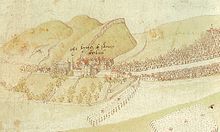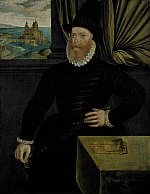Royal Court of Scotland
Little is known about the structure of the Scottish royal court in the period before the reign of David I when it began to take on a distinctly feudal character, with the major offices of the Steward, Chamberlain, Constable, Marischal and Lord Chancellor.
James VI employed two Flemish artists, Arnold Bronckorst and Adrian Vanson, who have left a visual record of the king and major figures at the court.
After James VI inherited the English throne in 1603 the Scottish court effectively ceased to exist, ending its role as a centre of artistic patronage, political display and intrigue.
[3] The court was severely disrupted during the Wars of Independence (1296–1357) and almost ceased to function, but was restored by Robert I and his Stuart successors, who attempted to embody national and dynastic identity.
Edinburgh only began to emerge as the capital in the reign of James III (r. 1460–88) at the cost of considerable unpopularity, as it was felt that the king's presence in the rest of the kingdom was part of his role.
The Chancellor, who was usually a clergyman in the Middle Ages, had charge of the king's chapel, which was also the major administrative centre of the crown, and had control of the letters, legal writs and seals.
[10] The second most prestigious office was now the Secretary, who was responsible for the records of the Privy Council and for foreign policy, including the borders, despite which the post retained its importance after the Union of Crowns in 1603.
[8] The council was a virtually full-time institution by the late fifteenth century, and surviving records from the period indicate that it was critical in the working of royal justice.
By the end of the fifteenth century, this group was being joined by increasing numbers of literate laymen, often secular lawyers, of which the most successful gained preferment in the judicial system and grants of lands and lordships.
[16] When the monarch was at one of the royal palaces or visiting a region of the kingdom on official business, the council would normally go with them and as a result of being away from its servants, records and members, its output tended to decrease.
[24] As the ruling elite gradually abandoned French, they began to adopt Middle Scots, and by the fifteenth century it was the language of government, with acts of parliament, council records and treasurer's accounts almost all using it from the reign of James I (r. 1406–37) onwards[24] and of the court soon after.
These occurred in 1449 at Stirling Castle in the reign of James II (r. 1437–60), where the Burgundian adventurer Jacques de Lalaing fought the greatest Scottish knights.
[26] Like most western European monarchies, the Scottish crown in the fifteenth century adopted the example of the Burgundian court, through formality and elegance putting itself at the centre of culture and political life, defined with display, ritual and pageantry, reflected in elaborate new palaces and patronage of the arts.
[28] Under James VI the court returned to being a centre of culture and learning and he cultivated the image of a philosopher king, evoking the models of David, Solomon and Constantine.
There are much fuller historical sources for Ireland, which suggest that there would have been filidh in Scotland, who acted as poets, musicians and historians, often attached to the court of a lord or king, and passed on their knowledge and culture in the Gaelic to the next generation.
[34] The captivity of James I in England from 1406 to 1423, where he earned a reputation as a poet and composer, may have led him to take English and continental styles and musicians back to the Scottish court on his release.
[36] An entry in the accounts of the Lord Treasurer of Scotland indicates that when James IV was at Stirling on 17 April 1497, there was a payment "to twa fithalaris [fiddlers] that sang Greysteil to the king, ixs".
[39] The return of Mary, Queen of Scots from France in 1561 to begin her personal reign, and her position as a Catholic, gave a new lease of life to the choir of the Chapel Royal, but the destruction of Scottish church organs meant that instrumentation to accompany the mass had to employ bands of musicians with trumpets, drums, fifes, bagpipes and tabors.
[45] The work was extremely popular among the Scots-speaking aristocracy, and Barbour is referred to as the father of Scots poetry, holding a similar place to his contemporary Chaucer in England.
[46] Much Middle Scots literature was produced by makars, poets with links to the royal court, which included James I, who wrote the extended poem The Kingis Quair.
[24] As a patron of poets and authors James V supported William Stewart and John Bellenden, who translated the Latin History of Scotland compiled in 1527 by Hector Boece, into verse and prose.
[50] From the 1550s, in the reign of Mary, Queen of Scots and the minority of her son James VI (r. 1567–1625), cultural pursuits were limited by the lack of a royal court and by political turmoil.
[51] He became patron and member of a loose circle of Scottish Jacobean court poets and musicians, later called the Castalian Band, which included William Fowler (c. 1560–1612), John Stewart of Baldynneis (c. 1545–c.
[56] Around 1500, about the same time as in England, Scottish monarchs turned to the recording of royal likenesses in panel portraits, painted in oils on wood, perhaps as a form of political expression.
[68] Rather than slavishly copying continental forms, elements of these styles were integrated into traditional local patterns,[69] and adapted to Scottish idioms and materials (particularly stone and harl).
[28] Work undertaken for James VI by William Schaw demonstrated continued Renaissance influences in the classical entrance of the Chapel Royal at Stirling, built in 1594.
[75] Mary, Queen of Scots' attempt to create a court in the image the French Renaissance monarchy was hampered by financial limitations, intensified by the general price inflation of the period.
[78] The last of the queen's dowry, 54,000 Danish dalers, which had been loaned to several Scottish towns was spent on the elaborate court entertainment and masque for the baptism of Prince of Wales in August 1594.
[28] After James VI inherited the English throne in 1603 the Scottish court effectively ceased to exist, ending its role as a centre of artistic patronage, political display and intrigue.
[80] A number of Scottish poets, including William Alexander, John Murray and Robert Aytoun accompanied the king to London, where they continued to write,[81] but they soon began to anglicise their written language.










